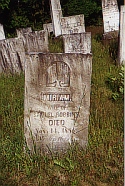
Some time before President Kennedy was elected, the route to my second-grade classroom took me through the Episcopal church cemetery in my hometown. Of course, I have walked through it hundreds of other times, but that must have been the first time I walked that way regularly, by myself.
I certainly wasn't afraid of it, with its casual rows of old stones lounging informally among the trees. It had a long wrought-iron fence with sharp-pointed pickets on three sides. The fourth was open to what must have been fields 150 years ago, when the fence was built. Later, the fields became a ball diamond, and the dead lost their solitude. We all gained something, though -- even though there were attempts from time to time to chain the gate at the east end.
There are dark pines -- I never walk over there -- and some ordinary hardwoods, and a couple of arbor vitae trees in the middle. The thin, papery stripes of their bark never fail to catch my eye. Over on my right there once were a couple of elm trees at least as tall as the church itself, but they are long gone, and the church has built a columbarium in the corner they shaded.
I recognize some of the names on the stones along my path as those of my hometown's founders, and I always wonder a little about what it must have been like to have lived so long ago, long enough to have died in the 1830s. Probably the stones woke my abiding interest in history, for I could see they had stories to tell that I simply wasn't learning about in school.
Everyone I know seems to love the old pioneer cemeteries. They're easy to love, with their quaint stones and picturesque locations on the tops of hills or under the wings of old churches. New ones aren't.
Grief still hangs on over the places of the more recent dead -- near my mother-in-law's grave in upstate New York there is a stone dedicated to a little girl whose relatives have left a set of sad little plastic shelves crowded with tiny, weathered gifts; small toys and decorations, plastic flowers, rain-splashed messages. Even though I don't know the names or the circumstance, the pitiable scene never fails to bring a lump to my throat.
There doesn't seem to be a place for that sort of thing is most cemeteries. In fact, many are quite specific about not permitting it. The great fields of dead I drive past around Cleveland often restrict themselves to flat plates in the ground: Labels, like the fronts of filing cabinets -- pull at this drawer and you have Isaac; pull here for Amy.
The flat stones create a parklike look, the brochures say. It's true -- and it's also much easier and cheaper to mow the grass. Such a place is too sterile and formal and controlled for raw sorrow, though, and that may be why departments of transportation tear their hair over the growing practice of placing memorials to the dead at the scenes of accidents, or, in the city, whereever an innocent has been killed.
Myself, I'd rather be cremated than filed away in a park. My personal preference would be to create some mischief, perhaps by having my ashes dropped from 2,000 feet to a spot just outside Jacobs Field in Cleveland, about 5 p.m. on a summer weekday. Someone who intended merely to be scattered over a California ballpark came down all at once like that in 2001, setting off a full-fledged terrorist-attack scramble that gave everyone some exercise even if it wasn't rush hour or a game day. It would be something to look forward to.
Out of respect for my kin, I will most likely niche out in a columbarium in some quiet spot someday. To be sure, they're even more like file cabinets than memorial parks -- well, maybe I can swing making a contribution to a sunny garden somewhere.
It's not an issue I spend a lot of time with. There is so much else outside the gates, after all.